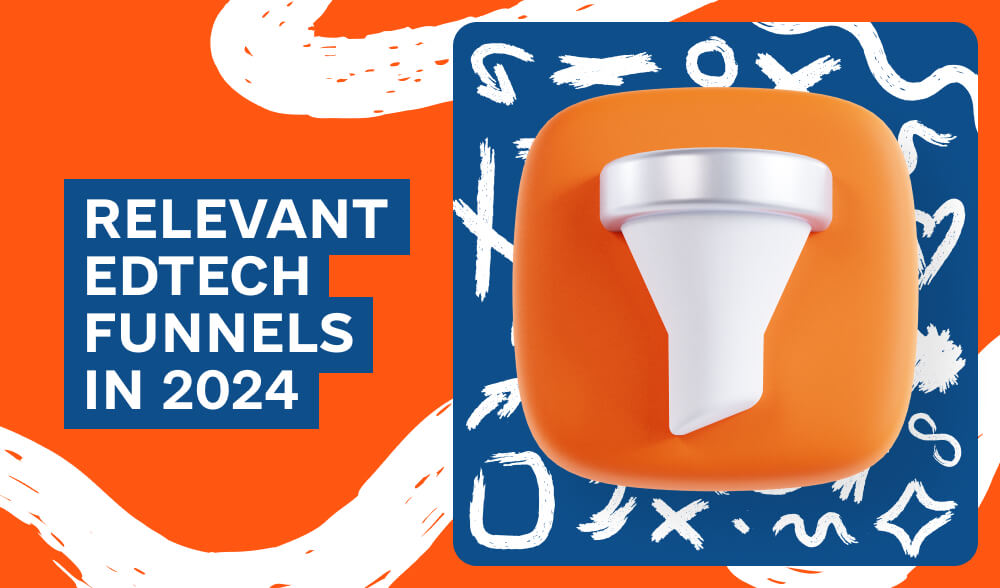Why you should pay attention to EdTech
According to Smart Ranking data for the first quarter of 2024, the EdTech market grew rapidly by 22.5%. A special breakthrough is observed in the educational software development segment, which showed more than 70% growth. An interesting point is that this year, the rates of development of additional vocational education and children’s education have almost equaled.
The revenue of the top 100 companies in the field of education and technology (EdTech) for the first quarter was 22.5% more than in the same period last year. Despite a slight decline compared to the fourth quarter of 2023, the overall trend remains positive.
These indicators demonstrate the active development of EdTech, which creates new opportunities for earnings. Attracting an audience to this area will definitely be profitable as the demand for educational courses continues to grow.
Which funnels work in 2024
EdTech has some interesting strategies for customer acquisition right now, and two of them stand out:
- Funnel via Telegram: A traffic stream is sent directly to a Telegram channel, for example, from Reels or TikTok. The channel can be thematic, such as Python for Beginners, or more general, such as How to Make Money Online. The main thing here is constant contact with the audience and maintaining interest in learning.
- Direct traffic to the landing page: It’s simple – create an interesting ad and run it through targeting. Facebook and Instagram are suitable channels. The formats are different: it can be a classic landing page or a page with a subscription to a Telegram bot for additional interaction.
Here’s another classic example: a user goes to the site from an advertisement and leaves contact information. Then the manager contacts them for consultation and sales.
There are also other ways to drive traffic to EdTech: for example, SEO with a focus on creating educational content on relevant topics or creating an educational platform like HubSpot. There is competition in this area due to other large projects.
You can also use affiliate links in thematic communities, although this requires more long-term planning and investment.
Influencer for EdTech: myth or reality?
Today, many people build an image of an influencer who sincerely shares their experience and useful advice. It works because the audience responds positively to this approach. The key point here is trust: people want to communicate with a real person, not just read high-quality but soulless texts.
To make an influencer look alive and real, you should post stories frequently, create interactive circles, and shoot YouTube videos where they can talk to the audience. This style helps to build a closer connection with subscribers.
Gradual “warming up” through personal stories, small successes, and even defeats also plays a role. People want to see not only victories, but also the path that the influencer has traveled to understand that they can achieve the same.
This creates the effect of long-term engagement, and “at the end of the journey” the influencer can offer a paid product or service. The more natural this process is, the more the audience’s trust grows. This often leads to increased conversion and sales growth. The main thing is consistency and sincerity in communication, which strengthens relationships and promotes brand development.
Types of payment models
In EdTech, CPL and CPS models are commonly used. The Revshare model is less popular here. In CPL, you get paid only for the lead, but in the case of CPS or CPA, you get a fixed amount or a percentage of the course sale. It usually takes up to two weeks to confirm a lead, and it can take 2-3 months to make a purchase decision, because people need time to understand the importance of learning. Educational courses are bought less frequently than, say, gambling services, so it is important to maintain long-term communication with the user to increase conversion.
Target audience: whom to focus on?
It is not always easy to identify the ideal audience, as it depends on the specifics of the product and its unique properties.
If we talk about EIT preparation courses, for example, the main audience is teenagers aged 15-17, among whom there are usually more girls. This can be explained by the fact that they are often more interested in learning and preparing for exams.
But we should also not forget about parents, who play an important role in choosing courses for their children. They are often the initiators of the choice and can influence the decision on a particular course. To engage this audience, you can use various platforms, such as TargetHunter, to target ads to parents and offer them relevant content.
Conclusion
EdTech is rapidly gaining momentum, and the demand for online courses is only growing every year. Now is the perfect time to try yourself in this niche. For newcomers, it is better to focus on pay-per-lead offers and offer users free materials, such as mini-courses or checklists via a chatbot. This approach minimizes risks, because in the first week, you can see how effective the traffic is and whether it pays off.


